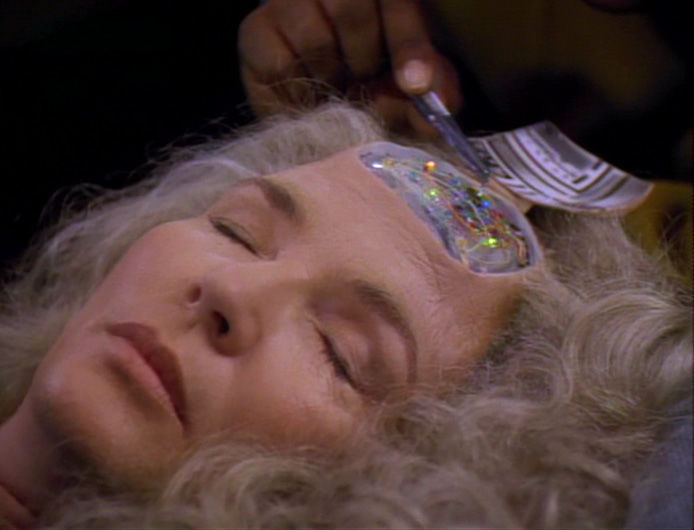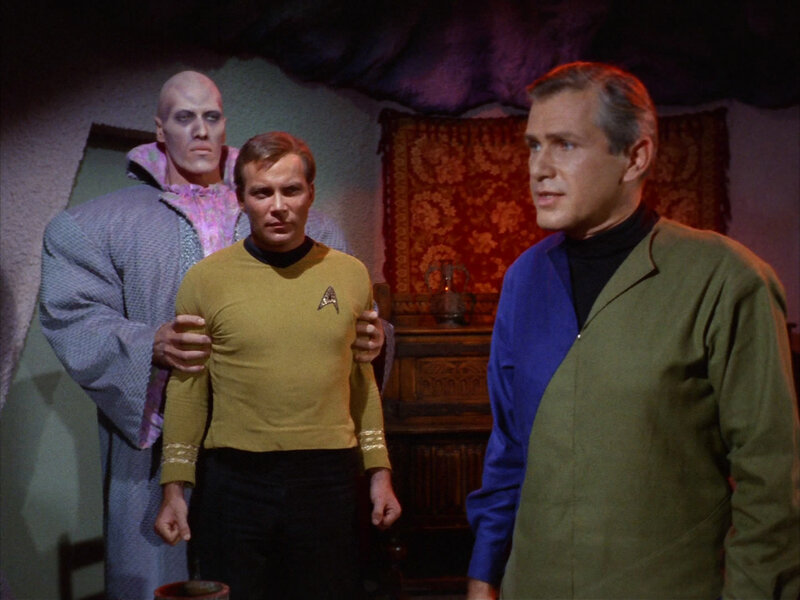Create a free profile to get unlimited access to exclusive videos, sweepstakes, and more!
Star Trek: Picard's premiere reveals new Android life and digs deep into Trek canon

Philip K. Dick may have famously wondered if androids dream of electric sheep, but Star Trek: Picard is wondering why ex-starship Captains dream about dead androids. In the opening scene to the newest ongoing Star Trek series, Jean-Luc Picard (Patrick Stewart) dreams of the deceased synthetic life form with a heart of gold, Lt. Commander Data (Brent Spiner). Later, Picard tells his Romulan housekeepers that "the dreams are lovely... it's the waking up I'm beginning to resent."
Jean-Luc is waking up to a changed Star Trek world, one that has taken various stories about A.I. from Star Trek: The Next Generation and given that future a hard left turn.
But, fear not Trekkie purists! None of this means that the fragile Star Trek canon has been changed, and in fact, all this new android stuff has a precedent. Here's how the plot of Picard has reimagined Trek's androids, and in doing so, rediscovered the wonder of one of science fiction's oldest conundrums: What happens when you make the perfect synthetic human?
**Spoiler Alert: There are spoilers below for Star Trek: Picard Season 1, Episode 1: "Remembrance."**
After dreaming of playing poker with Data aboard the USS Enterprise-D, we find Jean-Luc Picard at his family's wine vineyard, in La Barre, France. In case you forgot, despite his English accent, the character Jean-Luc Picard is French, which is why he has a French name and loves red wine. Jean-Luc is having a rough time, and things get even rowdier as we cut from 24th century France to 24th century Boston. Here we meet a bright young student named Dahj (Isa Briones), who is giving her boyfriend the good news that she just got accepted into the Daystrom Institute.
If you remember your Star Trek history, you might recall this is a really prestigious tech hotspot in the future. And, if you really remember your Star Trek history, you also might remember the Daystrom Institute gets its name from a guy named Richard Daystrom, who, in the original series episode "The Ultimate Computer," invented an A.I. that was supposed to run a starship — then, that A.I. started killing everyone until Kirk yelled at it. So, if hearing the word "Daystrom" makes you worried about rogue computers and killer robots, you're right! Because soon, Dahj and her boyfriend are attacked by helmeted thugs who are worried about her "activating."
Pretty soon, she activates, and like Trinity in The Matrix, easily takes out all of her attackers. From that point, the writing's pretty much on the wall: Dahj is some kind of android, and for some reason, she has visions of Picard. While this is going on, Jean-Luc gives a cranky interview to an interstellar news service that has promised not to ask him why he left Starfleet and then asks him why he left Starfleet. We're led to believe this news is for the people of the Federation, but really clever exposition for the audience.
See,14 years prior, Picard was all set to rescue the Romulans from a giant supernova (thanks for that, J.J. Abrams) but his plan got canceled after a bunch of Synths (a word now interchangeable with androids) went bananas on Mars and destroyed the rescue armada specifically built for this purpose. To this day, no one knows why the Synths went rogue, but all synthetic lifeforms were subsequently banned, and the Romulans were not rescued. Seemingly in protest, Picard left Starfleet, and at this point, is still clearly pretty ticked-off about all of it.
After walking out of the interview like a '90s British pop star, Jean-Luc has a glass of wine with his dog and quotes Shakespeare from All's Well That Ends Well.
Spoiler alert: Things do not end well.
Dahj finds Picard, and fairly quickly he decides that he's going to take care of her. After everybody has some tea and wine, Picard goes to bed and again dreams of Data. This time, though, his former android shipmate is asking him to help finish paint an oil painting. When Picard wakes up (he wakes up three times in this episode to be clear), he realizes he has a version of this painting in his house, and another version of the painting hidden away in what can only be called a high tech storage unit at Starfleet Headquarters. Dahj has mysteriously vanished, but Jean-Luc is way more interested in figuring out why he's dreaming of this painting.
In the one in his house, you can't see the face of the person in the painting, but when he hits up his storage unit, Picard finds another nearly identical painting, but this one has a face and it's Dahj. The painting is called "daughter."
Suddenly, Picard runs into Dahj, who followed him from France all the way to San Francisco, presumably by beaming around, but we're not really worried about that. Picard is convinced she's an android, and basically tells her this. Dahj doesn't accept it at first, but they don't have time to worry about it because pretty soon the thugs are back, and they're out to kill Dahj.
In the episode's biggest twist, these thugs — who are revealed to be Romulans — are successful. Dahj is blown up by a giant bomb. Jean-Luc wakes up for a third time, back at his house in France, but this time, none of that was a dream. It all really happened. Picard then hightails it to the Daystrom Institue in Okinawa where he meets a robotics expert named Dr. Agnes Jurati (Alison Pill).
Jurati's got nothing to do all day because studying actual androids has been banned, so Picard wants her to tell him how a flesh and blood android — who looks human inside and out — could be possible. She reveals to Picard that one of her colleagues, Bruce Maddox, was maybe fooling around with making secret fractal android clones. Bruce Maddox previously only appeared in one episode of Star Trek: The Next Generation — "The Measure of a Man" — in which Maddox briefly tried to rob Data of his autonomy, so, yes, this is a very deep Trekkie cut.
Eventually, after Picard shows Jurati Dahj's necklace, it's revealed that this special kind of android could be created in pairs; meaning, there is a second version of Dahj out there somewhere. From there, we cut to Romulan space, where a young woman who looks exactly like Dahj — and is called "Dr. Asha" — is working at some place called the "Romulan Reclamation Site." But, when the camera pulls back, this reclamation site is clearly a Borg ship. And cut to credits.
The return of the Borg ship is a pretty neat cliffhanger, but it's also not the big news.
From the trailers, we knew the Borg would be back, so that wasn't much of a shock. What is a shock is that Picard is floating a new kind of Star Trek android that is nearly exactly like older androids with one big difference: Presumably, Dahj (and her "sister" Soji) don't know they are androids, and would never be identified as such because any medical scan would make them look perfectly human.
Star Trek has come close to giving us this kind of android before, but not quite. Juliana Tainer (Fionnula Flanagan), a duplicate of Data's own human "mother" in the TNG episode "Inheritance," was similar: An android who believed she was human up until the moment the circuits in her head were revealed. In the original series episode "What Are Little Girls Made Of?," the deranged Dr. Roger Korby makes an android duplicate of Captain Kirk before it is eventually revealed that he, too, is an android duplicate of himself, complete with wires hanging out of his damaged hand. Androids that are supposed to pass for humans are also employed by con-man Harry Mudd in both Short Treks and the original series episode "I, Mudd."
And, yes, Data has had a daughter before, the android Lal (Hallie Todd), who was constructed by Data in "The Offspring," but tragically "died" because Data couldn't figure out how to make her positronic brain stable. Lal also knew exactly what she was, and had no delusions that she was android.
So, all of these previous Star Trek androids are close to the idea of Dahj and Soji, but with one crucial difference: They all had very visible circuitry once you got down to it. Other than her superhuman strength and classic Data processing speeds, Dahj bleeds like a human and, perhaps more importantly, thinks she is human. This makes her more like a Cylon from Battlestar Galactica or the replicants from Blade Runner than anything we've ever seen on Trek.
And yet, even those comparisons aren't quite right.
The episode begins with Picard wondering if Data has a "tell" during a game of poker. Most secret androids in all forms of science fiction tend to have a tell: circuits that spill out, robotic voices, or the deep need to say "affirmative" instead of "yes."
The Cylons on Battlestar had glowing red spines sometimes, and even the Replicants in Blade Runner were susceptible to the famous Voight-Kampff test that proved they were synthetic. Westworld hosts look human but underneath their skin, they all have very "robotic" exoskeletons and very obvious robot brains. So, although Picard is standing on the shoulders of all this Star Trek canon and a ton of other science fiction precedents that came before, these "flesh and blood" androids are the show's way of forging a path ahead.
With these robots, there's no "tell." At all. It's a small, subtle difference, but it is, in its own small way, a tiny bit of new blood in a long line of robot stories. These androids are virtually indistinguishable from humans. We can't tell them apart from us, and they're dreaming about humans.
The subtle change Star Trek: Picard has made to the robot formula is straightforward but smart. If robots were real, but there was nothing about them that was different other than their abilities and how they were made, would they still count as robots? It's not a new question per se, but Picard presents it in an innovative and elegant way. This may not be an entirely new, strange world of androids, but Star Trek: Picard is exploring it boldly.





























